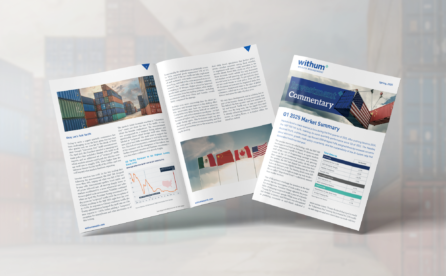2022 brought about a vicious end to the post-COVID market rally with a relentless onslaught of worrisome news – Russia’s invasion, persistently high inflation, an aggressive Federal Reserve and endless talks of recession. So far, the economy has been resilient, but stock and bond markets are signaling a tough road ahead. So, what’s ahead in 2023?
An underlying shift in what the market is considering “important” may be taking place. Inflation has likely peaked for some obvious and some other technical reasons. On the one hand, supply chains have eased, demand has shifted from goods to services and consumers have depleted much of the accumulated savings from various COVID stimulus packages. Technically speaking, the last five months of data have been more “normal”, annualizing just about 2.5%. If this more normal data continues, the high inflation months of last spring will fall off of the annual data, causing the headline 7.1% number to retreat.
Investors are becoming increasingly focused on company earnings. A brief example of the price to earnings (P/E) ratio is worthwhile. If a company earned $10/share in 2022 and trades at a 50 P/E multiple, that stock should be worth $500/share. If investors lose confidence in that company’s ability to produce earnings, even if earnings are consistent in 2023, the share price would drop – the same $10/share of earnings at a 40 P/E would mean a share price of $400 or a -20% decrease. If earnings shrink in 2023, while the multiple stays the same then the share price could also drop – $8/share of earnings at a 50 P/E multiple would mean a share price of $400 or a -20% decrease as well. In both scenarios, the share price dropped. If layoffs accelerate or weakening demand continues, this could impact both earnings and multiples.
While each company has a certain level of earnings, we can measure what this means for the greater market. Estimates for 2022 earnings are somewhere around $220 for the S&P500. 2023 estimates are currently for mild growth, however if a recession is coming, we typically see earnings drop 5-20% depending on the severity of the recession. This seems reasonable if spending continues to weaken amid rising costs compared to a year ago. The multiple investors are willing to pay for these earnings is notoriously hard to predict. At an average market multiple of 17.5x earnings of $220/share the S&P 500 should be fairly valued around 3850 – exactly where we find ourselves bouncing today. 17.5x however is a historical average and multiples fluctuate above and below the average depending on investor sentiment.
Which leads us to 2023. If we enter a recession next year or the Fed stays tighter than expected, we could be headed for dampening investor sentiment and a lower earnings multiple. A 15.5x multiple on $205/share of earnings would put the fair value of the market around 3170 on the S&P500. This would represent around a -35% peak to trough decline which is historically around average for bear market and recessionary environments – ouch.
Enough with the math already! The fact of the matter is no one knows what the future holds. Any number of things could cause a surge in investor optimism and the earnings multiple investors are willing to pay – a resolution in Russia, sensible Fed action to stop hiking rates so much, a new technological advance, aliens gifting us the cure for cancer – who knows?! Any of these things could send stocks skyrocketing, but most importantly, without notice. It’s simply not a wise move to sell stocks if there is a possibility of bad times ahead as the market is a forward-looking mechanism. Some degree of those bad times in the horizon could be already priced in and markets tend to turn around prior to the economy itself. Data shows that missing the best days in the market is far more harmful than participating in the bad days.
Stocks always price in future earnings expectations, so while the first half of 2023 could be volatile, there are reasons to be optimistic, longer-term. Once stocks start looking past a recession or earnings contraction, multiple expansion paired with earnings growth can provide above average market returns as the new bull market is born in the depths of poor economic data and pessimism.
Wishing you and your families continued health and success in the New Year.


